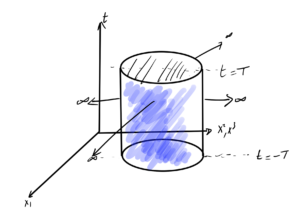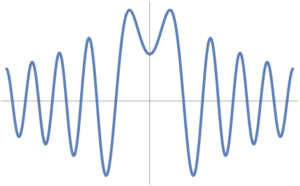[Click here for a PDF of this post with nicer formatting]
DISCLAIMER: Very rough notes from class, with some additional side notes.
These are notes for the UofT course PHY2403H, Quantum Field Theory I, taught by Prof. Erich Poppitz fall 2018.
1st Noether theorem.
Recall that, given a transformation
\begin{equation}\label{eqn:qftLecture8:20}
\phi(x) \rightarrow \phi(x) + \delta \phi(x),
\end{equation}
such that the transformation of the Lagrangian is only changed by a total derivative
\begin{equation}\label{eqn:qftLecture8:40}
\LL(\phi, \partial_\mu \phi) \rightarrow
\LL(\phi, \partial_\mu \phi)
+ \partial_\mu J_\epsilon^\mu,
\end{equation}
then there is a conserved current
\begin{equation}\label{eqn:qftLecture8:60}
j^\mu = \PD{(\partial_\mu \phi)}{\LL} \delta_\epsilon \phi – J_\epsilon^\mu.
\end{equation}
Here \( \epsilon \) is an x-independent quantity (i.e. a \underline{global symmetry}).
This is in contrast to “gauge symmetries”, which can be more accurately be categorized as a redundancy in the description.
As an example, for \( \LL = (\partial_\mu \phi \partial^\mu \phi – m^2 \phi^2)/2 \), let
\begin{equation}\label{eqn:qftLecture8:80}
\phi(x) \rightarrow \phi(x) – a^\mu \partial_\mu \phi
\end{equation}
\begin{equation}\label{eqn:qftLecture8:100}
\LL(\phi, \partial_\mu \phi) \rightarrow
\LL(\phi, \partial_\mu \phi)
– a^\mu \partial_\mu \LL
=
\LL(\phi, \partial_\mu \phi)
+ \partial_\mu \lr{ -{\delta^\mu}_\nu a^\nu \LL }
\end{equation}
Here \( J^\mu_\epsilon = \evalbar{J^\mu_\epsilon}{\epsilon = a^\nu} \), and the current is
\begin{equation}\label{eqn:qftLecture8:120}
J^\mu = (\partial^\mu \phi)(-a^\nu \partial_\nu \phi) + {\delta^{\mu}}_\nu a^\nu \LL.
\end{equation}
In particular, we have one such current for each \( \nu \), and we write
\begin{equation}\label{eqn:qftLecture8:140}
{T^\mu}_\nu =
-(\partial^\mu \phi)(\partial_\nu \phi) + {\delta^{\mu}}_\nu \LL.
\end{equation}
By Noether’s theorem, we must have
\begin{equation}\label{eqn:qftLecture8:160}
\partial_\mu
{T^\mu}_\nu = 0, \quad \forall \nu.
\end{equation}
Check:
\begin{equation}\label{eqn:qftLecture8:1380}
\begin{aligned}
\partial_\mu {T^\mu}_\nu
&=
-(\partial_\mu \partial^\mu \phi)(\partial_\nu \phi)
-(\partial^\mu \phi)(\partial_\mu \partial_\nu \phi)
+ {\delta^{\mu}}_\nu
\partial_\mu \lr{
\inv{2} \partial_\alpha \phi \partial^\alpha \phi – \frac{m^2}{2} \phi^2
} \\
&=
-(\partial_\mu \partial^\mu \phi)(\partial_\nu \phi)
-(\partial^\mu \phi)(\partial_\mu \partial_\nu \phi)
+
\inv{2} (\partial_\nu \partial_\mu \phi) (\partial^\mu \phi )
+
\inv{2} (\partial_\mu \phi) (\partial_\nu \partial^\mu \phi )
– m^2 (\partial_\nu \phi) \phi \\
&=
-\lr{ \partial_\mu \partial^\mu \phi + m^2 \phi }(\partial_\nu \phi)
-(\partial_\mu \phi)(\partial^\mu \partial_\nu \phi)
+
\inv{2} (\partial_\nu \partial^\mu \phi) (\partial_\mu \phi )
+
\inv{2} (\partial_\mu \phi) (\partial_\nu \partial^\mu \phi )
&= 0.
\end{aligned}
\end{equation}
Example: our potential Lagrangian
\begin{equation}\label{eqn:qftLecture8:180}
\LL = \inv{2} \partial^\mu \phi \partial_\nu \phi – \frac{m^2}{2} \phi^2 – \frac{\lambda}{4} \phi^4
\end{equation}
Written with upper indexes
\begin{equation}\label{eqn:qftLecture8:200}
\begin{aligned}
T^{\mu\nu}
&= -(\partial^\mu \phi)(\partial^\nu \phi) + g^{\mu\nu} \LL \\
&= -(\partial^\mu \phi)(\partial^\nu \phi) + g^{\mu\nu} \lr{
\inv{2} \partial^\alpha \phi \partial_\alpha \phi – \frac{m^2}{2} \phi^2 – \frac{\lambda}{4} \phi^4
}
\end{aligned}
\end{equation}
There are 4 conserved currents \( J^{\mu(\nu)} = T^{\mu\nu} \). Observe that this is symmetric (\( T^{\mu\nu} = T^{\nu\mu} \)).
We have four associated charges
\begin{equation}\label{eqn:qftLecture8:220}
Q^\nu = \int d^3 x T^{0 \nu}.
\end{equation}
We call
\begin{equation}\label{eqn:qftLecture8:240}
Q^0 = \int d^3 x T^{0 0},
\end{equation}
the energy density, and call
\begin{equation}\label{eqn:qftLecture8:260}
P^i = \int d^3 x T^{0 i},
\end{equation}
(i = 1,2,3) the momentum density.
writing this out explicitly the energy density is
\begin{equation}\label{eqn:qftLecture8:280}
\begin{aligned}
T^{00}
&= – \dot{\phi}^2 + \inv{2} \lr{ \dot{\phi}^2 – (\spacegrad \phi)^2 – \frac{m^2}{2}\phi^2 – \frac{\lambda}{4} \phi^4} \\
&= -\lr{
\inv{2} \dot{\phi}^2 + \inv{2} (\spacegrad \phi)^2 + \frac{m^2}{2}\phi^2 + \frac{\lambda}{4} \phi^4
},
\end{aligned}
\end{equation}
and
\begin{equation}\label{eqn:qftLecture8:300}
T^{0i} = \partial^0 \phi \partial^i \phi,
\end{equation}
\begin{equation}\label{eqn:qftLecture8:320}
P^{i} = -\int d^3 x\partial^0 \phi \partial^i \phi
\end{equation}
Since the energy density is negative definite (due to an arbitrary choice of translation sign), let’s redefine \( T^{\mu\nu} \) to have a positive sign
\begin{equation}\label{eqn:qftLecture8:340}
T^{00}
\equiv
\inv{2} \dot{\phi}^2 + \inv{2} (\spacegrad \phi)^2 + \frac{m^2}{2} \phi^2 + \frac{\lambda}{4} \phi^4,
\end{equation}
and
\begin{equation}\label{eqn:qftLecture8:360}
P^{i} = \int d^3 x\partial^0 \phi \partial^i \phi
\end{equation}
As an operator we have
\begin{equation}\label{eqn:qftLecture8:380}
\hatQ = \int d^3 x \hatT^{00} =
\int d^3 x
\lr{
\inv{2} \hat{\pi}^2 + \inv{2} (\spacegrad \phihat)^2 + \frac{m^2}{2} \phihat^2 + \frac{\lambda}{4} \phihat^4
}.
\end{equation}
\begin{equation}\label{eqn:qftLecture8:400}
\hatP^{i} = \int d^3 x \hat{\pi} \partial^i \phi
\end{equation}
We showed that
\begin{equation}\label{eqn:qftLecture8:420}
\ddt{\hatO} = i \antisymmetric{\hatH}{\hatO}
\end{equation}
This implied that \( \phihat, \hat{\pi} \) obey the classical EOMs
\begin{equation}\label{eqn:qftLecture8:440}
\ddt{\phihat} = i \antisymmetric{\hat{H}}{\phihat} = \ddt{\hat{\pi}}
\end{equation}
\begin{equation}\label{eqn:qftLecture8:460}
\ddt{\hat{\pi}} = i \antisymmetric{\hatH}{\hat{\pi}} = …
\end{equation}
In terms of creation and annihilation operators (for the \( \lambda = 0 \) free field), up to a constant
\begin{equation}\label{eqn:qftLecture8:480}
\begin{aligned}
\hatH
&= \int d^3 x \hatT^{00} \\
&= \int \frac{d^3 p}{(2 \pi)^3} \omega_\Bp \hat{a}_\Bp^\dagger \hat{a}_\Bp
\end{aligned}
\end{equation}
Can show that:
\begin{equation}\label{eqn:qftLecture8:500}
\begin{aligned}
\hatP^i
&= \int d^3 x \hat{\pi} \partial^i \phihat \\
&= \cdots \\
&= \int \frac{d^3 p}{(2 \pi)^3} p^i \hat{a}_\Bp^\dagger \hat{a}_\Bp
\end{aligned}
\end{equation}
Now we see the energy and momentum as conserved quantities associated with spacetime translation.
Unitary operators
In QM we say that \( \hat{\Bp} \) “generates translations”.
With \( \hat{\Bp} \equiv -i \Hbar \spacegrad \) that translation is
\begin{equation}\label{eqn:qftLecture8:520}
\hatU = e^{i \Ba \cdot \hat{\Bp}} = e^{\Ba \cdot \spacegrad}
\end{equation}
In particular
\begin{equation}\label{eqn:qftLecture8:540}
\bra{\Bx} \hatU \ket{\psi} = e^{\Ba \cdot \hat{\Bp} } \psi(\Bx) = \psi(\Bx + \Ba).
\end{equation}
In one dimension
\begin{equation}\label{eqn:qftLecture8:560}
\begin{aligned}
\hatU \hat{x} \hatU^\dagger
&=
e^{\Ba \cdot \hat{p} } \psi(\Bx)
e^{-\Ba \cdot \hat{p} } \\
&= \hat{\Bx} + a \hat{\mathbf{1}}.
\end{aligned}
\end{equation}
This uses the Baker-Campbell-Hausdorff formula.
Theorem: Baker-Campbell-Hausdorff
\begin{equation}\label{eqn:qftLecture8:600}
e^{B} A e^{-B} = \sum_{n = 0}^\infty \inv{n!} \antisymmetric{B \cdots}{\antisymmetric{B}{A}},
\end{equation}
where the n-th commutator is denoted above
- \( n = 1 \) : \( \antisymmetric{B}{A} \)
- \( n = 2 \) : \( \antisymmetric{B}{\antisymmetric{B}{A}} \)
- \( n = 3 \) : \( \antisymmetric{B}{\antisymmetric{B}{\antisymmetric{B}{A}}} \)
Proof:
\begin{equation}\label{eqn:qftLecture8:620}
\begin{aligned}
f(t)
&= e^{tB} A e^{-tB} \\
&= f(0) + t f'(0) + \frac{t^2}{2} f”(0) + \cdots \frac{t^n}{n!} f^{(n)}(0)
\end{aligned}
\end{equation}
\begin{equation}\label{eqn:qftLecture8:640}
f(0) = A
\end{equation}
\begin{equation}\label{eqn:qftLecture8:660}
\begin{aligned}
f'(t)
&=
e^{tB} B A e^{-tB}
+
e^{tB} A (-B) e^{-tB} \\
&=
e^{tB} \antisymmetric{B}{A} e^{-tB}
\end{aligned}
\end{equation}
\begin{equation}\label{eqn:qftLecture8:680}
\begin{aligned}
f”(t)
&=
e^{tB} B \antisymmetric{B}{A} e^{-tB}
+
e^{tB} \antisymmetric{B}{A} (-B) e^{-tB} \\
&=
e^{tB} \antisymmetric{B}{\antisymmetric{B}{A}} e^{-tB}.
\end{aligned}
\end{equation}
From
\begin{equation}\label{eqn:qftLecture8:700}
f(1)
= f(0) + f'(0) + \inv{2} f”(0) + \cdots \inv{n!} f^{(n)}(0)
\end{equation}
we have
\begin{equation}\label{eqn:qftLecture8:720}
e^{B} A e^{-B} = A +
\antisymmetric{B}{A} + \inv{2} \antisymmetric{B}{\antisymmetric{B}{A}} + \cdots
\end{equation}
Example:
\begin{equation}\label{eqn:qftLecture8:740}
\begin{aligned}
e^{a \partial_x} x e^{-a \partial_x }
&= x + a \antisymmetric{\partial_x}{x} + \cdots \\
&= x + a.
\end{aligned}
\end{equation}
Application:
\begin{equation}\label{eqn:qftLecture8:760}
e^{i \text{Hermitian} } = \text{unitary}
\end{equation}
\begin{equation}\label{eqn:qftLecture8:860}
e^{i \text{Hermitian} } \times
e^{-i \text{Hermitian} }
= 1
\end{equation}
So
\begin{equation}\label{eqn:qftLecture8:780}
\hatU(\Ba) =
e^{i a^j \hat{p}^j }
\end{equation}
is a unitary operator representing finite translations in a Hilbert space.
\begin{equation}\label{eqn:qftLecture8:800}
\begin{aligned}
\hatU(\Ba) \phihat(\Bx) \hatU^\dagger(\Ba)
&=
e^{i a^j \hat{p}^j }
\phihat(\Bx)
e^{-i a^k \hat{p}^k } \\
&=
\phihat(\Bx)
+ i a^j \antisymmetric{\hatP^j}{\phihat(\Bx)} + \frac{-a^{j_1} a^{j_2}}{2} \antisymmetric{\hatP^{j_1}}{\antisymmetric{\hatP^{j_2}}{\phihat(\Bx)}}
\end{aligned}
\end{equation}
\begin{equation}\label{eqn:qftLecture8:820}
\begin{aligned}
\antisymmetric{\hatP^j}{\phihat(\Bx)}
&=
\int d^3 y \antisymmetric{\hat{\pi}(\By) \partial^j \phihat(\By)}{\phihat(\Bx)} \\
&=
\int d^3 y \antisymmetric{\hat{\pi}(\By)}{\phihat(\Bx} \partial^j \phihat(\By) \\
&=
\int d^3 y (-i ) \delta^3(\By – \Bx) \partial^j \phihat(\By) \\
&=
-i \partial^j \phihat(\Bx).
\end{aligned}
\end{equation}
\begin{equation}\label{eqn:qftLecture8:840}
\begin{aligned}
\hatU(\Ba) \phihat(\Bx) \hatU^\dagger(\Ba)
&= \phihat(\Bx) + i a^j (-i) \partial^j \phihat(\Bx) + \cdots \\
&= \phihat(\Bx) + a^j \partial^j \phihat(\Bx) + \cdots \\
&= \phihat(\Bx + \Ba)
\end{aligned}
\end{equation}
Continuous symmetries
For all infinitesimal transformations, continuous symmetries lead to conserved charges \( Q \). In QFT we map these charges to Hermitian operators \( Q \rightarrow \hatQ \). We say that these charges are “generators of the corresponding symmetry” through unitary operators
\begin{equation}\label{eqn:qftLecture8:880}
\hatU = e^{i \text{parameter} \hatQ}.
\end{equation}
These represent the action of the symmetry in the Hilbert space.
Example: spatial translation
\begin{equation}\label{eqn:qftLecture8:900}
\hatU(\Ba) = e^{i \Ba \cdot \hat{\BP}}
\end{equation}
Example: time translation
\begin{equation}\label{eqn:qftLecture8:920}
\hatU(t) = e^{i t \hat{H}}.
\end{equation}
Classical scalar theory
For \( d > 2 \) let’s look at
\begin{equation}\label{eqn:qftLecture8:940}
S =
\int d^d x \lr{
\inv{2} \partial^\mu \phi \partial_\mu \phi – \frac{m^2}{2} \phi^2 – \lambda \phi^{d-2}
}
\end{equation}
Take \( m^2, \lambda \rightarrow 0 \), the free massless scalar field.
We have a shift symmetry in this case since \( \phi(x) \rightarrow \phi(x) + \text{constant} \).
The current is just
\begin{equation}\label{eqn:qftLecture8:960}
\begin{aligned}
j^\mu
&= \PD{(\partial_\mu \phi)}{\phi} \delta \phi – J^\mu \\
&= \PD{(\partial_\mu \phi)}{\phi} \delta \phi \\
&= \text{constant} \times \partial^\mu \phi \\
&= \partial^\mu \phi,
\end{aligned}
\end{equation}
where the constant factor has been set to one.
This current is clearly conserved since \( \partial_\mu J^\mu = \partial_\mu \partial^\mu \phi = 0\) (the equation of motion).
These are called “Goldstein Bosons”.
With \( m = \lambda = 0, d = 4 \) we have
NOTE: We did this in class differently with \( d \ne 4, m, \lambda \ne 0\), and then switched to \( m = \lambda = 0, d = 4\), which was confusing. I’ve reworked my notes to \( d = 4 \) like the supplemental handout that did the same.
\begin{equation}\label{eqn:qftLecture8:980}
S =
\int d^4 x \lr{
\inv{2} \partial^\mu \phi \partial_\mu \phi
}
\end{equation}
Here we have a scale or dilatation invariance
\begin{equation}\label{eqn:qftLecture8:1000}
x \rightarrow x’ = e^{\lambda} x,
\end{equation}
\begin{equation}\label{eqn:qftLecture8:1020}
\phi(x) \rightarrow \phi'(x’) = e^{-\lambda} \phi,
\end{equation}
\begin{equation}\label{eqn:qftLecture8:1040}
d^4 x \rightarrow d^4 x’ = e^{4\lambda} d^4 x,
\end{equation}
The partials transform as
\begin{equation}\label{eqn:qftLecture8:1400}
\partial^\mu \rightarrow
\PD{x’_\mu}{}
=
\PD{x’_\mu}{x_\mu}
\PD{x_\mu}{}
=
e^{-\lambda}
\PD{x_\mu}{}
\end{equation}
so the partial of the field transforms as
\begin{equation}\label{eqn:qftLecture8:1420}
\partial^\mu \phi(x) \rightarrow \PD{x’_\mu}{\phi'(x’)} = e^{-2\lambda} \partial^\mu \phi(x),
\end{equation}
and finally
\begin{equation}\label{eqn:qftLecture8:1060}
(\partial_\mu \phi)^2 \rightarrow e^{-4\lambda} \lr{ \partial_\mu \phi(x) }^2.
\end{equation}
With a \( -4 \lambda \) power in the transformed quadratic term, and \( 4 \lambda \) in the volume element, we see that the action is invariant.
To find Noether current, we need to vary the field and it’s derivatives
\begin{equation}\label{eqn:qftLecture8:1100}
\begin{aligned}
\delta_\lambda \phi
&= \phi'(x) – \phi(x) \\
&= \phi'(e^{-\lambda} x’) – \phi(x) \\
&\approx \phi'(x’ -\lambda x’) – \phi(x) \\
&\approx \phi'(x’) – \lambda {x’}^\alpha \partial_\alpha \phi'(x’) – \phi(x) \\
&\approx (1 – \lambda) \phi(x) – \lambda {x’}^\alpha \partial_\alpha \phi'(x’) – \phi(x) \\
&= – \lambda(1 + x^\alpha \partial_\alpha ) \phi,
\end{aligned}
\end{equation}
where the last step assumes that \( x’ \rightarrow x, \phi’ \rightarrow \phi \), effectively weeding out any terms that are quadratic or higher in \( \lambda \).
Now we need the variation of the derivatives of \( \phi \)
\begin{equation}\label{eqn:qftLecture8:1440}
\delta \partial_\mu \phi(x)
=
\partial_\mu’ \phi'(x) – \partial_\mu \phi(x),
\end{equation}
By \ref{eqn:qftLecture8:1420}
\begin{equation}\label{eqn:qftLecture8:1460}
\begin{aligned}
\partial_\mu’ \phi'(x’)
&=
e^{-2\lambda} \partial_\mu \phi(x) \\
&=
e^{-2\lambda} \partial_\mu \phi(e^{-\lambda} x’) \\
&\approx
e^{-2\lambda} \partial_\mu
\lr{
\phi(x’) – \lambda {x’}^\alpha \partial_\alpha \phi(x’)
} \\
&\approx
\lr{
1 – 2 \lambda
}
\partial_\mu
\lr{
\phi(x’) – \lambda {x’}^\alpha \partial_\alpha \phi(x’)
},
\end{aligned}
\end{equation}
so
\begin{equation}\label{eqn:qftLecture8:1480}
\begin{aligned}
\delta \partial_\mu \phi
&=
– \lambda {x}^\alpha \partial_\alpha \partial_\mu \phi(x)
– 2 \lambda \partial_\mu \phi(x) + O(\lambda^2) \\
&=
– \lambda \lr{
{x}^\alpha \partial_\alpha + 2
}
\partial_\mu \phi(x).
\end{aligned}
\end{equation}
\begin{equation}\label{eqn:qftLecture8:1200}
\begin{aligned}
\delta \LL
&=
(\partial^\mu \phi) \delta (\partial_\mu \phi) \\
&= – \lambda \lr{ 2
\partial_\mu \phi
+ x^\alpha \partial_\alpha
\partial_\mu \phi
}
\partial^\mu \phi,
\end{aligned}
\end{equation}
or
\begin{equation}\label{eqn:qftLecture8:1500}
\begin{aligned}
\frac{\delta \LL }{-\lambda}
&=
4 \LL + x^\alpha \lr{ \partial_\alpha \partial_\mu \phi } \partial^\mu \phi \\
&=
4 \LL + x^\alpha \partial_\alpha \lr{ \LL } \\
&=
{4 \LL} + \partial_\alpha \lr{ x^\alpha \LL } – {\LL \partial_\alpha x^\alpha} \\
&=
\partial_\alpha \lr{ x^\alpha \LL }.
\end{aligned}
\end{equation}
The variation in the Lagrangian density is thus
\begin{equation}\label{eqn:qftLecture8:1520}
\delta \LL = \partial_\mu J^\mu_\lambda = \partial_\mu \lr{ -\lambda x^\mu \LL },
\end{equation}
and the current is
\begin{equation}\label{eqn:qftLecture8:1540}
J^\mu_\lambda = -\lambda x^\mu \LL.
\end{equation}
The Noether current is
\begin{equation}\label{eqn:qftLecture8:1240}
\begin{aligned}
j^\mu
&= \PD{(\partial_\mu \phi)}{\LL} \delta \phi – J^\mu \\
&= -\partial^\mu \phi \lr{ 1 + x^\nu \partial_\nu } \phi + \inv{2} x^\mu \partial_\nu \phi \partial^\nu \phi,
\end{aligned}
\end{equation}
or after flipping signs
\begin{equation}\label{eqn:qftLecture8:1280}
\begin{aligned}
j^\mu_{\text{dil}}
&= \partial^\mu \phi \lr{ 1 + x^\nu \partial_\nu } \phi – \inv{2} x^\mu
\partial_\nu \phi \partial^\nu \phi \\
&= x_\nu \lr{ \partial^\mu \phi \partial^\nu \phi – \inv{2} {\delta^{\nu}}_\mu \partial_\lambda \phi \partial^\lambda \phi }
+ \inv{2} \partial^\mu (\phi^2),
\end{aligned}
\end{equation}
\begin{equation}\label{eqn:qftLecture8:1300}
j^\mu_{\text{dil}} = -x_\nu T^{\nu \mu} + \inv{2} \partial^\mu (\phi^2),
\end{equation}
The current and \( T^{\mu\nu} \) can both be redefined \( j^{\mu’} = j^\mu + \partial_\nu C^{\nu\mu} \) adding an antisymmetric \( C^{\mu\nu} = -C^{\nu\mu} \)
\begin{equation}\label{eqn:qftLecture8:1320}
j^\mu_{\text{dil conformal}} = – x_\nu T^{\nu\mu}_{\text{conformal}}
\end{equation}
\begin{equation}\label{eqn:qftLecture8:1340}
\partial_\mu
j^\mu_{\text{dil conformal}} = – {{T_{\text{conformal}}}^\mu}_\mu
\end{equation}
consequence: \( 0 = T^{00} – T^{11} – T^{22} – T^{33} \), which is essentially
\begin{equation}\label{eqn:qftLecture8:1360}
0 = \rho – 3 p = 0.
\end{equation}
Like this:
Like Loading...

